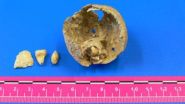(Press-News.org) A team of researchers led by the UAB has found the first ancient remains of a calcified ovarian teratoma, in the pelvis of the skeleton of a woman from the Roman era. The find confirms the presence in antiquity of this type of tumour - formed by the remains of tissues or organs, which are difficult to locate during the examination of ancient remains. Inside the small round mass, four teeth and a small piece of bone were found.
Teratomas are usually benign and contain remains of organic material, such as hair, teeth, bones and other tissues. There are no references in the literature to ovarian teratomas in ancient remains like those found in this study, led by the researcher Núria Armentano of the Biological Anthropology Unit of the UAB and published in the International Journal of Paleopathology.
The tumour in question is rounded in shape, with a wrinkled surface, of the same colour as the bones, about 43 mm long and 44 mm in diameter. It was found in the right-hand part of the pelvis of a woman of between 30 and 40 years of age and who lived around 1,600 years ago, and came from the Roman cemetery in the archaeological site of La Fogonussa (Lleida). A macroscopic examination and a scan revealed four teeth of anomalous morphology inside the tumour, two of which were adhering to the inside wall of the tumour, and a small bone fragment.
"The calcification and preservation of the external walls of this tumour are exceptional, since these types of remains usually only retain the internal structures and the extremely fragile external ones disappear", explains Assumpció Malgosa, co-author of the study.
In fact, there are very few differential diagnoses of pelvic and abdominal calcifications in archaeological contexts, among other reasons because it is so difficult to determine their nature - they could be kidney stones, fibromas, teratomas, arterial remains, etc. etc. Moreover, they are hard to spot during the excavation and can easily be mistaken for stones.
Teratomas are asymptomatic in 60% of cases, but on occasion they cause torsions and functional problems in nearby organs, by compression when they are large. Pregnancy seems to favour certain complications in teratomas, such as complications on giving birth. Nevertheless, nowadays they seldom grow large and calcify even less often, because they are detected and operated on very early.
In the case of the Roman woman the researchers do not discount the possibility that the tumour was the cause of death, though this cannot be certain. It is also possible that she lived all her life with the calcified tumour with no further complications.
The skeleton was recovered in 2010 during the excavation of 46 graves in La Fogonussa, and formed part of a total of 87 skeletons. It was complete and well-preserved, buried in a tile grave.
INFORMATION:
The study was carried out by researchers from the Biological Anthropology Unit of the UAB, ANTROPÒLEGS.LAB, the Institute of Legal Medicine of Catalonia, the Sacred Heart University Hospital of Barcelona and the Lleida-based company Iltirta Archaeology.
Ovarian tumor, with teeth and a bone fragment inside, found in a Roman-age skeleton
2013-01-24
ELSE PRESS RELEASES FROM THIS DATE:
Medical cannabis provides dramatic relief for sufferers of chronic ailments
2013-01-24
Though controversial, medical cannabis has been gaining ground as a valid therapy, offering relief to suffers of diseases such as cancer, Post-Traumatic Stress Disorder, ALS and more. The substance is known to soothe severe pain, increase the appetite, and ease insomnia where other common medications fail.
In 2009, Zach Klein, a graduate of Tel Aviv University's Department of Film and Television Studies, directed the documentary Prescribed Grass. Through the process, he developed an interest in the scientific research behind medical marijuana, and now, as a specialist ...
Cancer expert remains to be convinced by breast screening review
2013-01-24
Michael Baum, Professor emeritus of surgery at University College London says that, while deaths from breast cancer may be avoided, any benefit will be more than outweighed by deaths due to the long term adverse effects of treatment.
He estimates that, for every 10, 000 women invited for screening, three to four breast cancer deaths are avoided at the cost of 2.72 to 9.25 deaths from the long term toxicity of radiotherapy.
These figures contrast with an independent report on breast cancer screening, led by Sir Michael Marmot and published in November last year. Marmot ...
Tracking the spread of dengue fever: Domestic networks drive rapid transmission of human infection
2013-01-24
The mosquitoes that spread dengue fever tap into the domestic networks of humans, along with their bloodstreams, finds a study recently published in the Proceedings of the National Academy of Sciences (PNAS).
The data from Iquitos, Peru, shows that the trail of the most rapid transmission of human infections does not lead through large, public gathering places, as might be expected, but from house-to-house, as people visit nearby friends and relatives.
"It's common in a dengue fever outbreak to first treat public places like schools for mosquitoes, but our results show ...
New, cost-cutting approach to formulating pest-killing fungi
2013-01-24
This press release is available in Spanish.
Biopesticides containing beneficial fungi are often grown on grains or other solids, but U.S. Department of Agriculture (USDA) scientists have shown a liquid diet can work better.
The approach, dubbed "liquid culture fermentation," offers several benefits, including lower material costs and increased yields of certain forms of insect-killing fungi, including Isaria or Metarhizium, which can serve as biobased alternatives to synthetic pesticides.
For decades, biopesticide makers have grown such fungi on moistened grains ...
The 3D fireworks of a star
2013-01-24
In 1901 the star GK Persei gave off a powerful explosion that has not stopped growing and astonishing ever since. Now a team of Spanish and Estonian astronomers has reconstructed the journey of the emitted gas in 3D which, contrary to predictions, has hardly slowed down its speed of up to 1,000 km/s after all this time.
Thanks to the images captured from the Isaac Newton Telescope and the Nordic Optical Telescope in La Palma (Canary Islands, Spain), a European team of astronomers has constructed a three dimensional map of the remnant of a nova, or in other words, what ...
'Connection error' in the brains of anorexics
2013-01-24
RUB researchers find altered connectivity in the brain network for body perception.
The weaker the connection, the greater the misjudgement of body shape
When people see pictures of bodies, a whole range of brain regions are active. This network is altered in women with anorexia nervosa. In a functional magnetic resonance imaging study, two regions that are important for the processing of body images were functionally more weakly connected in anorexic women than in healthy women. The stronger this "connection error" was, the more overweight the respondents considered ...
Researchers prevent cancer spread by blocking tissue scarring
2013-01-24
What to fear most if faced by a cancer diagnosis is the spread of the cancer to other parts of the body. This process called metastasis accounts for over 90% of cancer patient deaths and therefore is a strong focus for cancer researchers. Researchers at BRIC, University of Copenhagen have shown that the enzyme Lysyl Oxidase (LOX) can create a "scarred" microenvironment that enhances cancer spreading. By blocking activity of the LOX enzyme, the researchers succeeded in significantly decreasing metastasis in a model of breast cancer.
'When we inhibit the activity of LOX ...
Synthetic corkscrew peptide kills antibiotic-resistant Gram-negative bacteria
2013-01-24
HOUSTON – An engineered peptide provides a new prototype for killing an entire category of resistant bacteria by shredding and dissolving their double-layered membranes, which are thought to protect those microbes from antibiotics.
The synthetic peptide was effective in lab experiments against antibiotic-resistant Gram-negative bacteria, which cause a variety of difficult-to-treat, potentially lethal infections such as pneumonia and sepsis.
The team led by scientists at The University of Texas MD Anderson Cancer Center reported its findings online in advance of print ...
Introducing 'more patient reality' into NHS spending decisions
2013-01-24
A study by health economists at the University of York has, for the first time, produced an estimate of the impact on other NHS patients of new and more costly drugs and other treatments.
This research suggests a refinement of the way the National Institute for Health and Clinical Excellence (NICE) gauges the cost-effectiveness of new interventions. It also has implications for the prices that the NHS can afford to pay for new drugs when the value-based pricing scheme for all new drugs is introduced by the Government in 2014.
The project was funded by the Medical Research ...
Pitt team finds 'Achilles Heel' of key HIV replication protein
2013-01-24
PITTSBURGH, Jan. 24, 2013 – Researchers at the University of Pittsburgh School of Medicine may have found an "Achilles heel" in a key HIV protein. In findings published online today in Chemistry and Biology, they showed that targeting this vulnerable spot could stop the virus from replicating, potentially thwarting HIV infection from progressing to full-blown AIDS.
Previous research demonstrated that a small HIV protein called Nef interacts with many other proteins in infected cells to help the virus multiply and hide from the immune system. The Pitt group developed a ...

